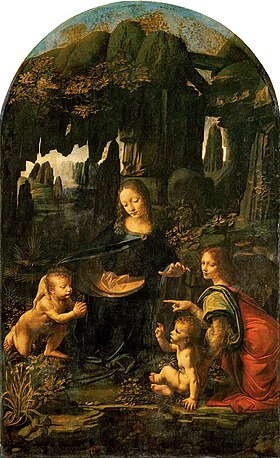
The Virgin of the Rocks (sometimes the Madonna of the Rocks) is the name used for two paintings by Leonardo da Vinci, of the same subject, and of a composition which is identical except for several significant details. The version generally considered the prime version, that is the earlier of the two, hangs in The Louvre in Paris and the other in the National Gallery, London. The paintings are both nearly 2 metres (over 6 feet) high and are painted in oils. Both were painted on wooden panel; that in the Louvre has been transferred to canvas.[1]
Both paintings show the Madonna and Child Jesus with the infant John the Baptist and an angel, in a rocky setting which gives the paintings their usual name. The significant compositional differences are in the gaze and right hand of the angel. There are many minor ways in which the works differ, including the colours, the lighting, the flora, and the way in whichsfumato has been used. Although the date of an associated commission is documented, the complete histories of the two paintings are unknown, and lead to speculation about which of the two is earlier.
Two further paintings are associated with the commission: side panels each containing an angel playing a musical instrument and completed by associates of Leonardo. These are both in the National Gallery, London.
The Virgin of the Rocks which usually hangs in the Louvre is considered by most art historians to be the earlier of the two and date from around 1483–1486. Most authorities agree that the work is entirely by Leonardo.[2] It is about 8 cm (3 in) taller than the London version. The first certain record of this picture is in 1625, when it was in the French royal collection. It is generally accepted that this painting was produced to fulfill a commission of 1483 in Milan. It is hypothesised that this painting was privately sold by Leonardo and that the London version was painted at a later date to fill the commission.[2]There are a number of other theories to explain the existence of two paintings.[3][4] This painting is regarded as a perfect example of Leonardo's "sfumato" technique.
A very similar painting in the National Gallery, London, is also ascribed to Leonardo da Vinci, and ascribed a date before 1508.[5] Originally thought to have been partially painted by Leonardo's assistants, study of the painting during the recent restoration have led the conservators from the National Gallery to conclude that the greater part of the work is by the hand of Leonardo.[6] However its precise attribution is still the subject of a debate.[7] It was painted for the chapel of the Confraternity of the Immaculate Conception, in the church of San Francesco Maggiore in Milan. It was sold by the church, very likely in 1781, and certainly by 1785, when it was bought by Gavin Hamilton, who took it to England. After passing through various collections, it was bought by the National Gallery in 1880.
Two paintings of angels playing musical instruments are believed to have been part of the composition that was set into the altarpiece. These two pictures, now in the National Gallery, London, are thought to have been completed between 1490 and 1495. One, an angel in red, is thought to be the work of Ambrogio de Predis while the angel in green is thought to be the work of a different assistant of Leonardo, perhaps Francesco Napoletano
Two paintings of angels playing musical instruments are believed to have been part of the composition that was set into the altarpiece. These two pictures, now in the National Gallery, London, are thought to have been completed between 1490 and 1495. One, an angel in red, is thought to be the work of Ambrogio de Predis while the angel in green is thought to be the work of a different assistant of Leonardo, perhaps Francesco Napoletano
岩间圣母是指列奥纳多·达·芬奇的两幅画板油画的统称,这两幅画构图基本相同,一幅画作于1483年至1486年,现藏于卢浮宫[1],另一幅画于1491年至1508年,现藏英国国家美术馆。
這幅畫的特點很多。陰暗的畫面,帶出一種神秘感。顏色則是暖色。構圖是一個帶有充份安定感的三角形構圖,以聖母為頂。人物有交流,以手勢來表達。人物的動作代表了心中所想。聖母有自然的微笑。用了薄霧法,做出暈染的效果。
典藏在羅浮宮的版本,約在1483年至1486年之間或之前完成.多數的權威學者同意此畫作大部份是達文西所畫的,是兩件作品中比較早完成的。[2]細膩的畫工和使用明暗對比法被視為達文西作品的特徵.它比倫敦版本長約8公分.這幅畫最早的記錄是在1625年,那時候它屬於法國皇室的收藏。[2]羅浮宮版本因"達文西密碼"而受矚目,然而藝術歷史學家並不認同書裡所付予其中的"隱藏意義".
在倫敦國家畫廊藏有達文西另一幅大同小異的畫作,大概1508年之前完成.有助手幫忙畫了一些部分,助手可能是de Predis兄弟.這幅畫原來是為聖母無原罪兄弟會的禮拜堂--米蘭聖芳濟大教堂而作,約在1781-1785年畫作被教堂賣給蓋文漢米頓(Gavin Hamilton),他帶到英國。之後經過多次輾轉收藏買賣,最後在1880年倫敦國家美術畫廊買下它。[2]
在2005年6月,用紅外線進行分析發現有別的畫作被覆蓋在下,圖案是一個跪著的女子一手抱著嬰兒,另一手展開,部分研究者認為可能作者原來要畫的主題是朝拜初生的耶穌。[3]其實現代有許多圖稿用x-光或紅外線檢查時被發現出來。
No comments:
Post a Comment